Employment Law: Health, Safety, Dismissal, and Unfair Dismissal
VerifiedAdded on 2022/09/22
|8
|1741
|23
Homework Assignment
AI Summary
This assignment delves into the intricacies of Australian employment law, addressing key areas such as workplace health and safety duties, summary dismissal, and unfair dismissal claims. The first part of the assignment outlines the duties of employers, employees, manufacturers, and workplace managers, along with factors determining the fulfillment of these duties, as per the Occupational Safety and Health Act. The second part examines the lawful reasons for summary dismissal, providing examples of misconduct, violence, dishonesty, and insubordination that justify termination. The assignment then presents a case study involving Mickey, a Human Resources General Manager, whose position is restructured due to company expansion. The analysis considers the requirements for providing notice of position changes and the applicability of the genuine redundancy provisions under the Fair Work Act 2009, ultimately concluding that Mickey's claim of unfair dismissal is not sustainable. References to relevant legislation and case law are included throughout the analysis.
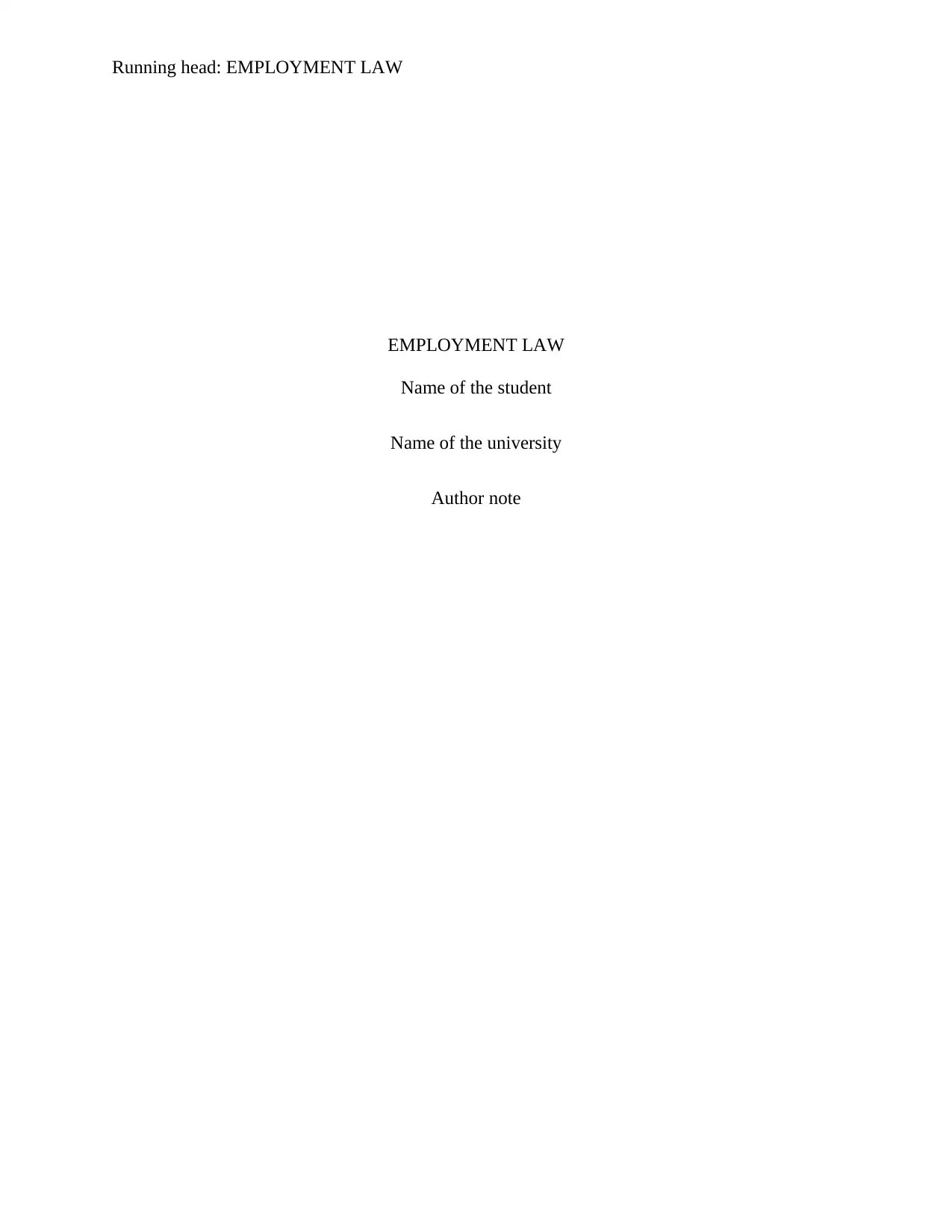
Running head: EMPLOYMENT LAW
EMPLOYMENT LAW
Name of the student
Name of the university
Author note
EMPLOYMENT LAW
Name of the student
Name of the university
Author note
Paraphrase This Document
Need a fresh take? Get an instant paraphrase of this document with our AI Paraphraser
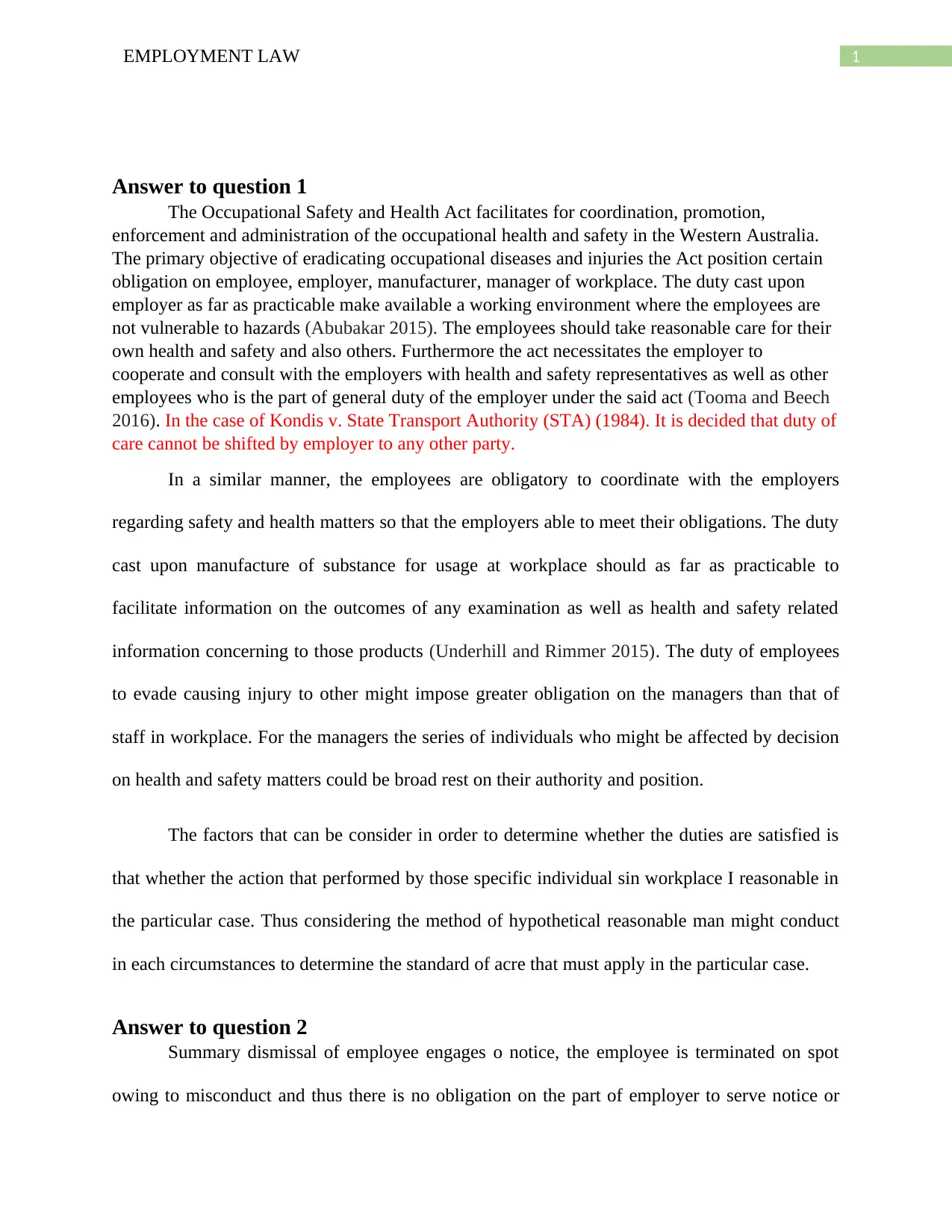
1EMPLOYMENT LAW
Answer to question 1
The Occupational Safety and Health Act facilitates for coordination, promotion,
enforcement and administration of the occupational health and safety in the Western Australia.
The primary objective of eradicating occupational diseases and injuries the Act position certain
obligation on employee, employer, manufacturer, manager of workplace. The duty cast upon
employer as far as practicable make available a working environment where the employees are
not vulnerable to hazards (Abubakar 2015). The employees should take reasonable care for their
own health and safety and also others. Furthermore the act necessitates the employer to
cooperate and consult with the employers with health and safety representatives as well as other
employees who is the part of general duty of the employer under the said act (Tooma and Beech
2016). In the case of Kondis v. State Transport Authority (STA) (1984). It is decided that duty of
care cannot be shifted by employer to any other party.
In a similar manner, the employees are obligatory to coordinate with the employers
regarding safety and health matters so that the employers able to meet their obligations. The duty
cast upon manufacture of substance for usage at workplace should as far as practicable to
facilitate information on the outcomes of any examination as well as health and safety related
information concerning to those products (Underhill and Rimmer 2015). The duty of employees
to evade causing injury to other might impose greater obligation on the managers than that of
staff in workplace. For the managers the series of individuals who might be affected by decision
on health and safety matters could be broad rest on their authority and position.
The factors that can be consider in order to determine whether the duties are satisfied is
that whether the action that performed by those specific individual sin workplace I reasonable in
the particular case. Thus considering the method of hypothetical reasonable man might conduct
in each circumstances to determine the standard of acre that must apply in the particular case.
Answer to question 2
Summary dismissal of employee engages o notice, the employee is terminated on spot
owing to misconduct and thus there is no obligation on the part of employer to serve notice or
Answer to question 1
The Occupational Safety and Health Act facilitates for coordination, promotion,
enforcement and administration of the occupational health and safety in the Western Australia.
The primary objective of eradicating occupational diseases and injuries the Act position certain
obligation on employee, employer, manufacturer, manager of workplace. The duty cast upon
employer as far as practicable make available a working environment where the employees are
not vulnerable to hazards (Abubakar 2015). The employees should take reasonable care for their
own health and safety and also others. Furthermore the act necessitates the employer to
cooperate and consult with the employers with health and safety representatives as well as other
employees who is the part of general duty of the employer under the said act (Tooma and Beech
2016). In the case of Kondis v. State Transport Authority (STA) (1984). It is decided that duty of
care cannot be shifted by employer to any other party.
In a similar manner, the employees are obligatory to coordinate with the employers
regarding safety and health matters so that the employers able to meet their obligations. The duty
cast upon manufacture of substance for usage at workplace should as far as practicable to
facilitate information on the outcomes of any examination as well as health and safety related
information concerning to those products (Underhill and Rimmer 2015). The duty of employees
to evade causing injury to other might impose greater obligation on the managers than that of
staff in workplace. For the managers the series of individuals who might be affected by decision
on health and safety matters could be broad rest on their authority and position.
The factors that can be consider in order to determine whether the duties are satisfied is
that whether the action that performed by those specific individual sin workplace I reasonable in
the particular case. Thus considering the method of hypothetical reasonable man might conduct
in each circumstances to determine the standard of acre that must apply in the particular case.
Answer to question 2
Summary dismissal of employee engages o notice, the employee is terminated on spot
owing to misconduct and thus there is no obligation on the part of employer to serve notice or
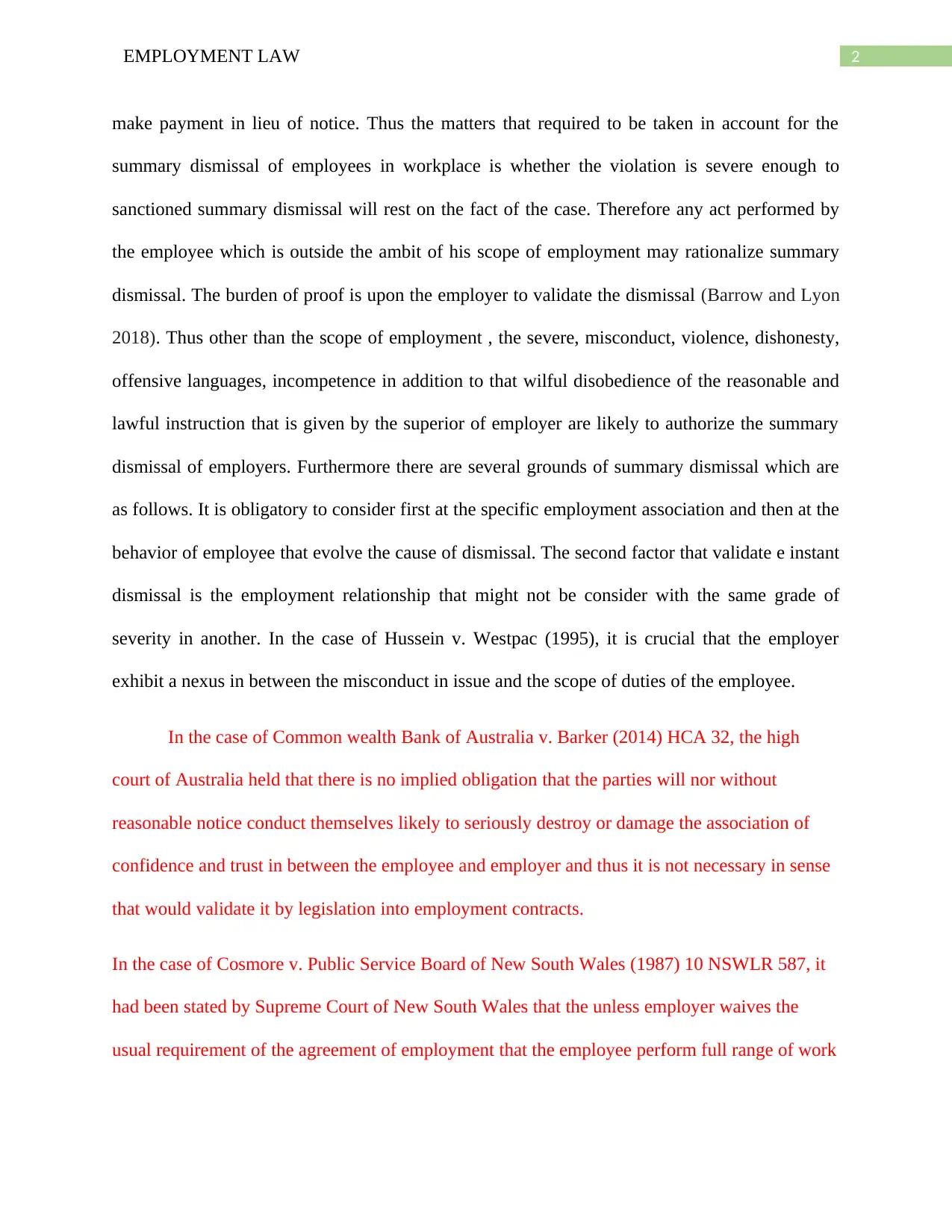
2EMPLOYMENT LAW
make payment in lieu of notice. Thus the matters that required to be taken in account for the
summary dismissal of employees in workplace is whether the violation is severe enough to
sanctioned summary dismissal will rest on the fact of the case. Therefore any act performed by
the employee which is outside the ambit of his scope of employment may rationalize summary
dismissal. The burden of proof is upon the employer to validate the dismissal (Barrow and Lyon
2018). Thus other than the scope of employment , the severe, misconduct, violence, dishonesty,
offensive languages, incompetence in addition to that wilful disobedience of the reasonable and
lawful instruction that is given by the superior of employer are likely to authorize the summary
dismissal of employers. Furthermore there are several grounds of summary dismissal which are
as follows. It is obligatory to consider first at the specific employment association and then at the
behavior of employee that evolve the cause of dismissal. The second factor that validate e instant
dismissal is the employment relationship that might not be consider with the same grade of
severity in another. In the case of Hussein v. Westpac (1995), it is crucial that the employer
exhibit a nexus in between the misconduct in issue and the scope of duties of the employee.
In the case of Common wealth Bank of Australia v. Barker (2014) HCA 32, the high
court of Australia held that there is no implied obligation that the parties will nor without
reasonable notice conduct themselves likely to seriously destroy or damage the association of
confidence and trust in between the employee and employer and thus it is not necessary in sense
that would validate it by legislation into employment contracts.
In the case of Cosmore v. Public Service Board of New South Wales (1987) 10 NSWLR 587, it
had been stated by Supreme Court of New South Wales that the unless employer waives the
usual requirement of the agreement of employment that the employee perform full range of work
make payment in lieu of notice. Thus the matters that required to be taken in account for the
summary dismissal of employees in workplace is whether the violation is severe enough to
sanctioned summary dismissal will rest on the fact of the case. Therefore any act performed by
the employee which is outside the ambit of his scope of employment may rationalize summary
dismissal. The burden of proof is upon the employer to validate the dismissal (Barrow and Lyon
2018). Thus other than the scope of employment , the severe, misconduct, violence, dishonesty,
offensive languages, incompetence in addition to that wilful disobedience of the reasonable and
lawful instruction that is given by the superior of employer are likely to authorize the summary
dismissal of employers. Furthermore there are several grounds of summary dismissal which are
as follows. It is obligatory to consider first at the specific employment association and then at the
behavior of employee that evolve the cause of dismissal. The second factor that validate e instant
dismissal is the employment relationship that might not be consider with the same grade of
severity in another. In the case of Hussein v. Westpac (1995), it is crucial that the employer
exhibit a nexus in between the misconduct in issue and the scope of duties of the employee.
In the case of Common wealth Bank of Australia v. Barker (2014) HCA 32, the high
court of Australia held that there is no implied obligation that the parties will nor without
reasonable notice conduct themselves likely to seriously destroy or damage the association of
confidence and trust in between the employee and employer and thus it is not necessary in sense
that would validate it by legislation into employment contracts.
In the case of Cosmore v. Public Service Board of New South Wales (1987) 10 NSWLR 587, it
had been stated by Supreme Court of New South Wales that the unless employer waives the
usual requirement of the agreement of employment that the employee perform full range of work
⊘ This is a preview!⊘
Do you want full access?
Subscribe today to unlock all pages.

Trusted by 1+ million students worldwide
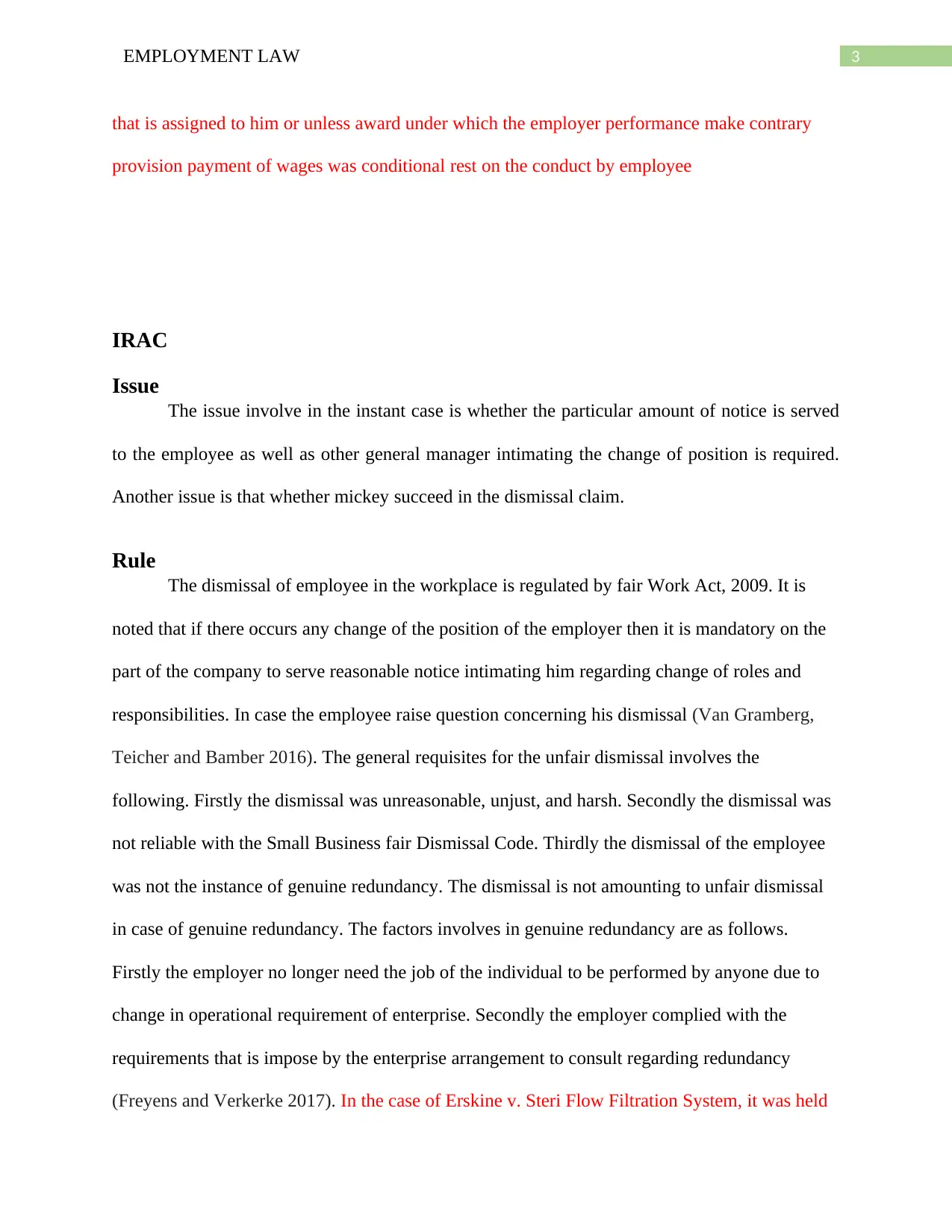
3EMPLOYMENT LAW
that is assigned to him or unless award under which the employer performance make contrary
provision payment of wages was conditional rest on the conduct by employee
IRAC
Issue
The issue involve in the instant case is whether the particular amount of notice is served
to the employee as well as other general manager intimating the change of position is required.
Another issue is that whether mickey succeed in the dismissal claim.
Rule
The dismissal of employee in the workplace is regulated by fair Work Act, 2009. It is
noted that if there occurs any change of the position of the employer then it is mandatory on the
part of the company to serve reasonable notice intimating him regarding change of roles and
responsibilities. In case the employee raise question concerning his dismissal (Van Gramberg,
Teicher and Bamber 2016). The general requisites for the unfair dismissal involves the
following. Firstly the dismissal was unreasonable, unjust, and harsh. Secondly the dismissal was
not reliable with the Small Business fair Dismissal Code. Thirdly the dismissal of the employee
was not the instance of genuine redundancy. The dismissal is not amounting to unfair dismissal
in case of genuine redundancy. The factors involves in genuine redundancy are as follows.
Firstly the employer no longer need the job of the individual to be performed by anyone due to
change in operational requirement of enterprise. Secondly the employer complied with the
requirements that is impose by the enterprise arrangement to consult regarding redundancy
(Freyens and Verkerke 2017). In the case of Erskine v. Steri Flow Filtration System, it was held
that is assigned to him or unless award under which the employer performance make contrary
provision payment of wages was conditional rest on the conduct by employee
IRAC
Issue
The issue involve in the instant case is whether the particular amount of notice is served
to the employee as well as other general manager intimating the change of position is required.
Another issue is that whether mickey succeed in the dismissal claim.
Rule
The dismissal of employee in the workplace is regulated by fair Work Act, 2009. It is
noted that if there occurs any change of the position of the employer then it is mandatory on the
part of the company to serve reasonable notice intimating him regarding change of roles and
responsibilities. In case the employee raise question concerning his dismissal (Van Gramberg,
Teicher and Bamber 2016). The general requisites for the unfair dismissal involves the
following. Firstly the dismissal was unreasonable, unjust, and harsh. Secondly the dismissal was
not reliable with the Small Business fair Dismissal Code. Thirdly the dismissal of the employee
was not the instance of genuine redundancy. The dismissal is not amounting to unfair dismissal
in case of genuine redundancy. The factors involves in genuine redundancy are as follows.
Firstly the employer no longer need the job of the individual to be performed by anyone due to
change in operational requirement of enterprise. Secondly the employer complied with the
requirements that is impose by the enterprise arrangement to consult regarding redundancy
(Freyens and Verkerke 2017). In the case of Erskine v. Steri Flow Filtration System, it was held
Paraphrase This Document
Need a fresh take? Get an instant paraphrase of this document with our AI Paraphraser
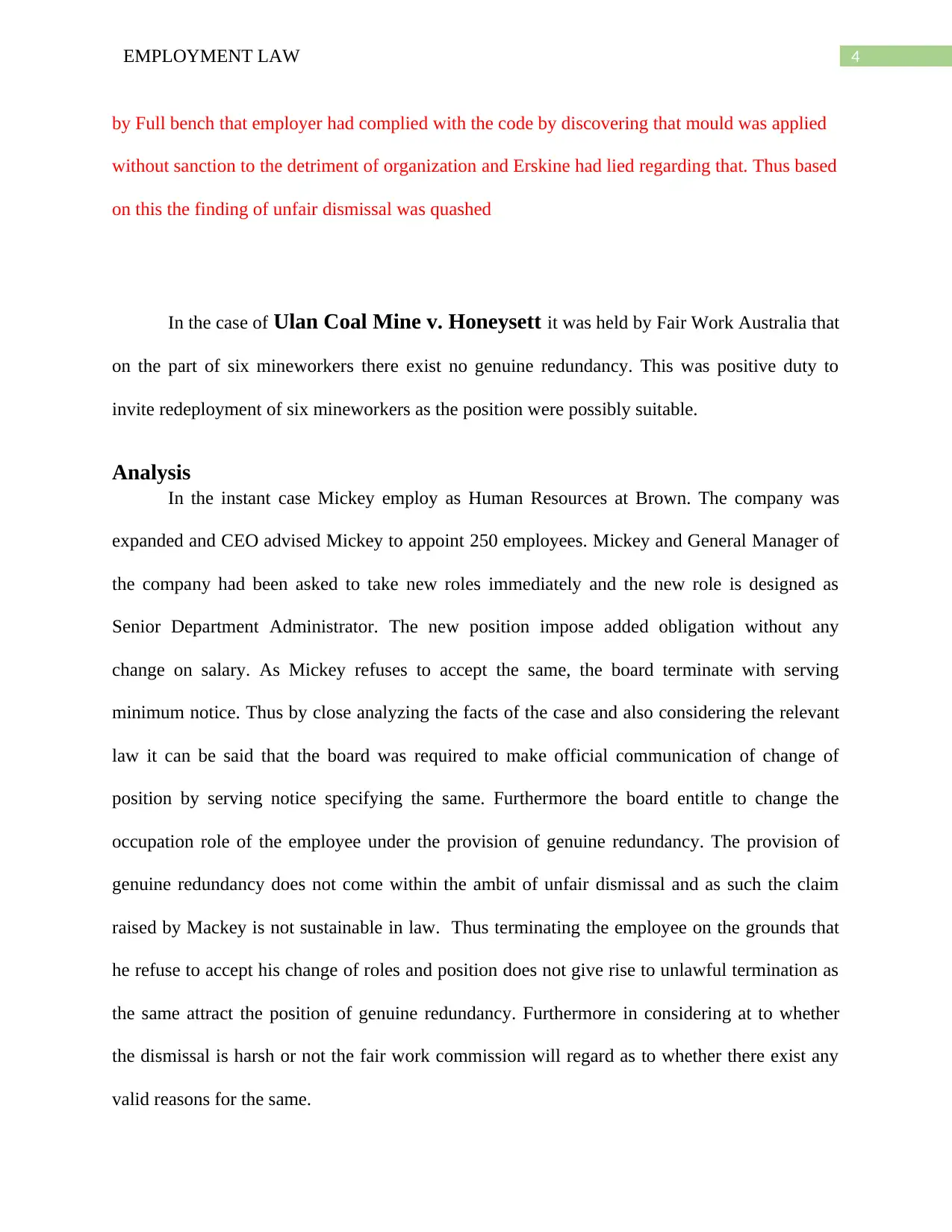
4EMPLOYMENT LAW
by Full bench that employer had complied with the code by discovering that mould was applied
without sanction to the detriment of organization and Erskine had lied regarding that. Thus based
on this the finding of unfair dismissal was quashed
In the case of Ulan Coal Mine v. Honeysett it was held by Fair Work Australia that
on the part of six mineworkers there exist no genuine redundancy. This was positive duty to
invite redeployment of six mineworkers as the position were possibly suitable.
Analysis
In the instant case Mickey employ as Human Resources at Brown. The company was
expanded and CEO advised Mickey to appoint 250 employees. Mickey and General Manager of
the company had been asked to take new roles immediately and the new role is designed as
Senior Department Administrator. The new position impose added obligation without any
change on salary. As Mickey refuses to accept the same, the board terminate with serving
minimum notice. Thus by close analyzing the facts of the case and also considering the relevant
law it can be said that the board was required to make official communication of change of
position by serving notice specifying the same. Furthermore the board entitle to change the
occupation role of the employee under the provision of genuine redundancy. The provision of
genuine redundancy does not come within the ambit of unfair dismissal and as such the claim
raised by Mackey is not sustainable in law. Thus terminating the employee on the grounds that
he refuse to accept his change of roles and position does not give rise to unlawful termination as
the same attract the position of genuine redundancy. Furthermore in considering at to whether
the dismissal is harsh or not the fair work commission will regard as to whether there exist any
valid reasons for the same.
by Full bench that employer had complied with the code by discovering that mould was applied
without sanction to the detriment of organization and Erskine had lied regarding that. Thus based
on this the finding of unfair dismissal was quashed
In the case of Ulan Coal Mine v. Honeysett it was held by Fair Work Australia that
on the part of six mineworkers there exist no genuine redundancy. This was positive duty to
invite redeployment of six mineworkers as the position were possibly suitable.
Analysis
In the instant case Mickey employ as Human Resources at Brown. The company was
expanded and CEO advised Mickey to appoint 250 employees. Mickey and General Manager of
the company had been asked to take new roles immediately and the new role is designed as
Senior Department Administrator. The new position impose added obligation without any
change on salary. As Mickey refuses to accept the same, the board terminate with serving
minimum notice. Thus by close analyzing the facts of the case and also considering the relevant
law it can be said that the board was required to make official communication of change of
position by serving notice specifying the same. Furthermore the board entitle to change the
occupation role of the employee under the provision of genuine redundancy. The provision of
genuine redundancy does not come within the ambit of unfair dismissal and as such the claim
raised by Mackey is not sustainable in law. Thus terminating the employee on the grounds that
he refuse to accept his change of roles and position does not give rise to unlawful termination as
the same attract the position of genuine redundancy. Furthermore in considering at to whether
the dismissal is harsh or not the fair work commission will regard as to whether there exist any
valid reasons for the same.
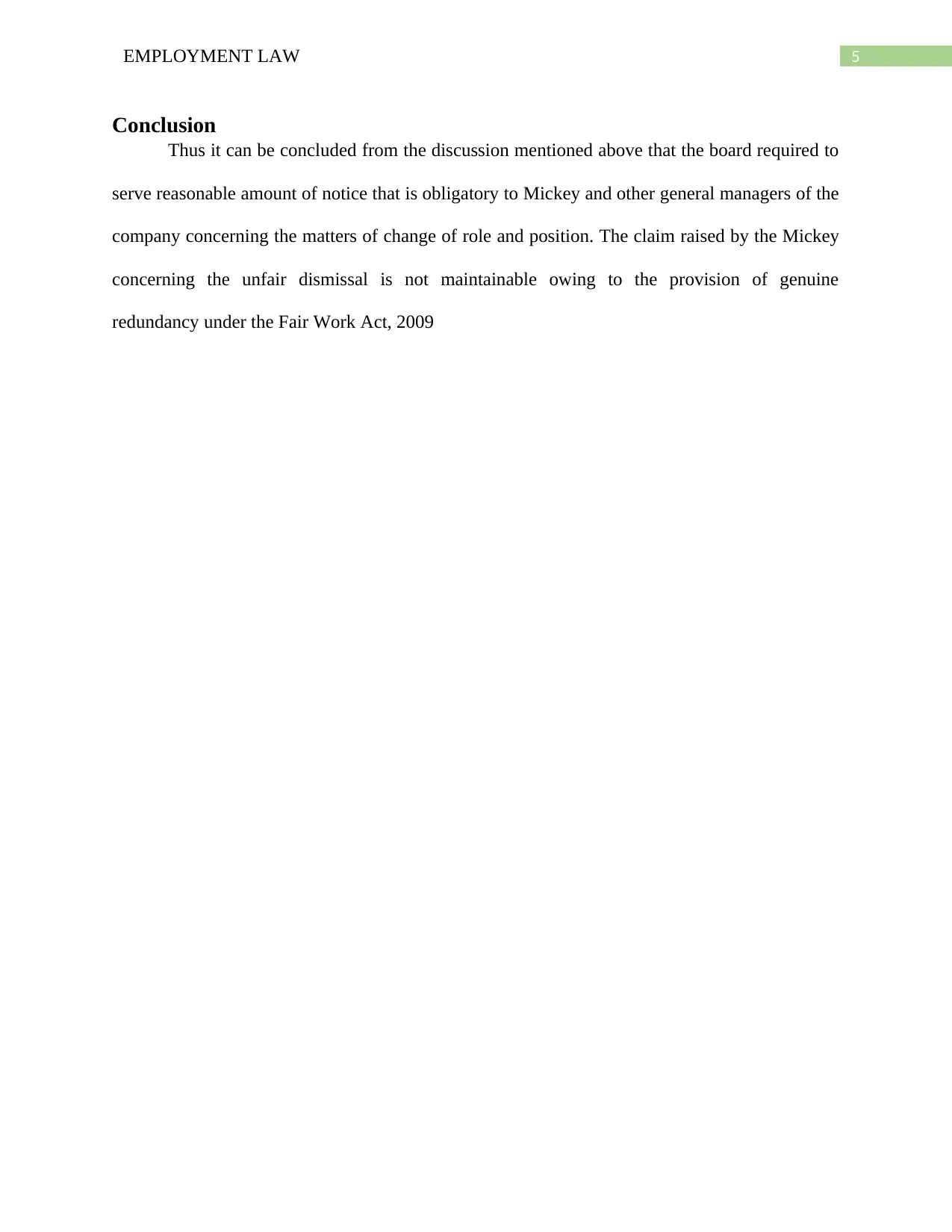
5EMPLOYMENT LAW
Conclusion
Thus it can be concluded from the discussion mentioned above that the board required to
serve reasonable amount of notice that is obligatory to Mickey and other general managers of the
company concerning the matters of change of role and position. The claim raised by the Mickey
concerning the unfair dismissal is not maintainable owing to the provision of genuine
redundancy under the Fair Work Act, 2009
Conclusion
Thus it can be concluded from the discussion mentioned above that the board required to
serve reasonable amount of notice that is obligatory to Mickey and other general managers of the
company concerning the matters of change of role and position. The claim raised by the Mickey
concerning the unfair dismissal is not maintainable owing to the provision of genuine
redundancy under the Fair Work Act, 2009
⊘ This is a preview!⊘
Do you want full access?
Subscribe today to unlock all pages.

Trusted by 1+ million students worldwide
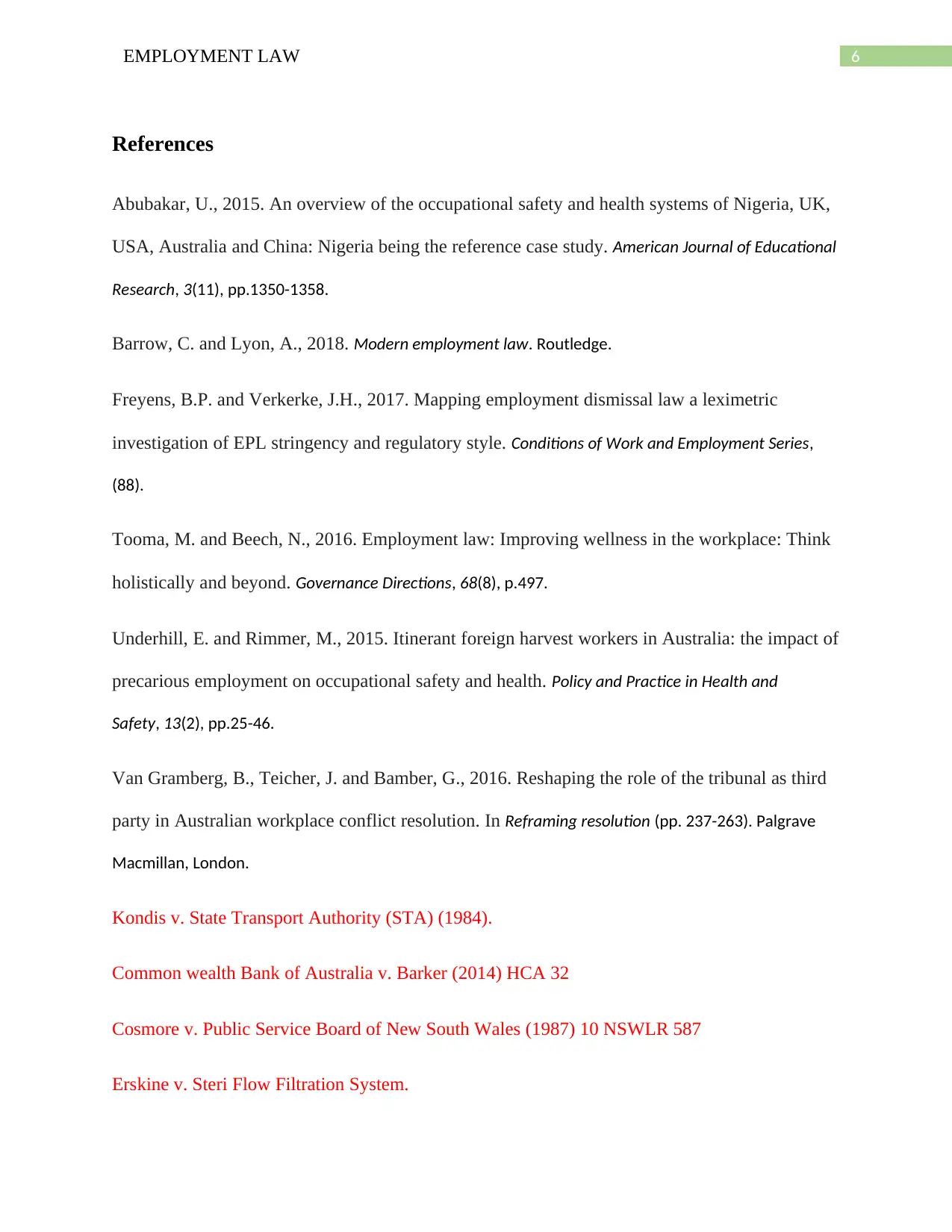
6EMPLOYMENT LAW
References
Abubakar, U., 2015. An overview of the occupational safety and health systems of Nigeria, UK,
USA, Australia and China: Nigeria being the reference case study. American Journal of Educational
Research, 3(11), pp.1350-1358.
Barrow, C. and Lyon, A., 2018. Modern employment law. Routledge.
Freyens, B.P. and Verkerke, J.H., 2017. Mapping employment dismissal law a leximetric
investigation of EPL stringency and regulatory style. Conditions of Work and Employment Series,
(88).
Tooma, M. and Beech, N., 2016. Employment law: Improving wellness in the workplace: Think
holistically and beyond. Governance Directions, 68(8), p.497.
Underhill, E. and Rimmer, M., 2015. Itinerant foreign harvest workers in Australia: the impact of
precarious employment on occupational safety and health. Policy and Practice in Health and
Safety, 13(2), pp.25-46.
Van Gramberg, B., Teicher, J. and Bamber, G., 2016. Reshaping the role of the tribunal as third
party in Australian workplace conflict resolution. In Reframing resolution (pp. 237-263). Palgrave
Macmillan, London.
Kondis v. State Transport Authority (STA) (1984).
Common wealth Bank of Australia v. Barker (2014) HCA 32
Cosmore v. Public Service Board of New South Wales (1987) 10 NSWLR 587
Erskine v. Steri Flow Filtration System.
References
Abubakar, U., 2015. An overview of the occupational safety and health systems of Nigeria, UK,
USA, Australia and China: Nigeria being the reference case study. American Journal of Educational
Research, 3(11), pp.1350-1358.
Barrow, C. and Lyon, A., 2018. Modern employment law. Routledge.
Freyens, B.P. and Verkerke, J.H., 2017. Mapping employment dismissal law a leximetric
investigation of EPL stringency and regulatory style. Conditions of Work and Employment Series,
(88).
Tooma, M. and Beech, N., 2016. Employment law: Improving wellness in the workplace: Think
holistically and beyond. Governance Directions, 68(8), p.497.
Underhill, E. and Rimmer, M., 2015. Itinerant foreign harvest workers in Australia: the impact of
precarious employment on occupational safety and health. Policy and Practice in Health and
Safety, 13(2), pp.25-46.
Van Gramberg, B., Teicher, J. and Bamber, G., 2016. Reshaping the role of the tribunal as third
party in Australian workplace conflict resolution. In Reframing resolution (pp. 237-263). Palgrave
Macmillan, London.
Kondis v. State Transport Authority (STA) (1984).
Common wealth Bank of Australia v. Barker (2014) HCA 32
Cosmore v. Public Service Board of New South Wales (1987) 10 NSWLR 587
Erskine v. Steri Flow Filtration System.
Paraphrase This Document
Need a fresh take? Get an instant paraphrase of this document with our AI Paraphraser

7EMPLOYMENT LAW
Hussein v. Westpac (1995)
Ulan Coal Mine v. Honeysett
Fair Work Act, 2009
Hussein v. Westpac (1995)
Ulan Coal Mine v. Honeysett
Fair Work Act, 2009
1 out of 8
Related Documents
Your All-in-One AI-Powered Toolkit for Academic Success.
+13062052269
info@desklib.com
Available 24*7 on WhatsApp / Email
![[object Object]](/_next/static/media/star-bottom.7253800d.svg)
Unlock your academic potential
Copyright © 2020–2025 A2Z Services. All Rights Reserved. Developed and managed by ZUCOL.




